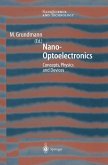Optoelectronic devices are being developed at an extraordinary rate. Organic light emitting diodes, photovoltaic devices and electro-optical modulators are pivotal to the future of displays, photosensors and solar cells, and communication technologies. This book details the theories underlying the relevant mechanisms in organic materials and covers, at a basic level, how the organic components are made.
The first part of this book introduces the fundamental theories used to detail ordered solids and localised energy levels. The methods used to determine energy levels in perfectly ordered molecular and macromolecular systems are discussed, making sure that the effects of quasi-particles are not missed. The function of excitons and their transfer between two molecules are studied, and the problems associated with interfaces and charge injection into resistive media are presented.
The second part details technological aspects such as the fabrication of devices based on organic materials by dry etching. The principal characterisation techniques are highlighted. Specific attention is paid to the use of organic light emitting diodes in visual displays, the conversion of photons into electricity in photovoltaic cells, and the electro-optical modulation of signals in communication and information technologies.
Professor André Moliton is the Director of the " Unité de Microélectronique, Optoélectronique et Polymères " (UMOP - CNRS FRE 2701) at the Université de Limoges, France. The translator, Dr Roger C. Hiorns, is a post-doc at the Laboratoire de Physico-Chimie des Polymères at the Université de Pau et des Pays de l'Adour, France.
The first part of this book introduces the fundamental theories used to detail ordered solids and localised energy levels. The methods used to determine energy levels in perfectly ordered molecular and macromolecular systems are discussed, making sure that the effects of quasi-particles are not missed. The function of excitons and their transfer between two molecules are studied, and the problems associated with interfaces and charge injection into resistive media are presented.
The second part details technological aspects such as the fabrication of devices based on organic materials by dry etching. The principal characterisation techniques are highlighted. Specific attention is paid to the use of organic light emitting diodes in visual displays, the conversion of photons into electricity in photovoltaic cells, and the electro-optical modulation of signals in communication and information technologies.
Professor André Moliton is the Director of the " Unité de Microélectronique, Optoélectronique et Polymères " (UMOP - CNRS FRE 2701) at the Université de Limoges, France. The translator, Dr Roger C. Hiorns, is a post-doc at the Laboratoire de Physico-Chimie des Polymères at the Université de Pau et des Pays de l'Adour, France.
Dieser Download kann aus rechtlichen Gründen nur mit Rechnungsadresse in A, B, BG, CY, CZ, D, DK, EW, E, FIN, F, GR, HR, H, IRL, I, LT, L, LR, M, NL, PL, P, R, S, SLO, SK ausgeliefert werden.









